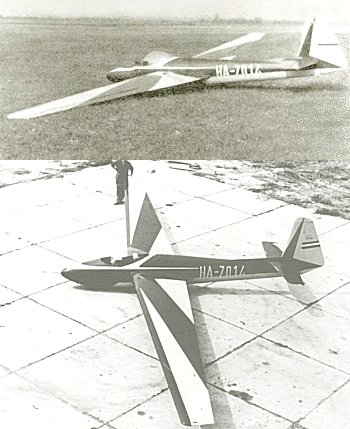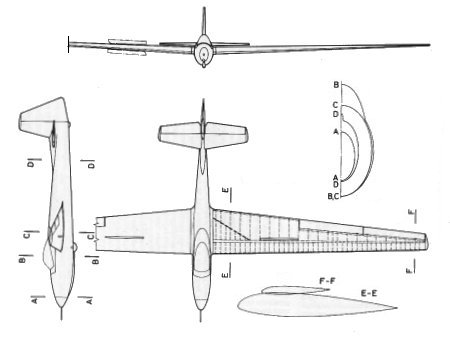HUNGARIAN
GLIDERS
1933-2000
| Type designation: |
Z-04 |
| Name: |
Béke |
| Designer: |
Ferenc ZSEBŐ and his team: János CSERKUTI, Győző SAJGÓ, Ferenc SAMU, György SURI and József TÓTH |
| Class: |
Aerobatic |
| General arrangement: |
Cantilever mid-wing, fixed wheel, traditional tail unit, mixed wooden-light metal structure |
| Crew: |
1 |
| First flight: |
June, 1955 |
| Manufacturer: |
Central Workshop of the Hungarian Aeronautical Association, Dunakeszi |
| Number of built: |
1 |

Short history:
In 1954 to replace the phasing out popular aerobatic glider, LF-107 Lunak, a fully aerobatic glider was ordered by MÖHOSZ, the central organization controlling all the flying sports in Hungary, from the Central Workshop of the Hungarian Aeronautical Association, Dunakeszi. Based on the experiences had been gained operating Lunaks, the basic requirements formulated for the new glider were harmonized controls with light control forces, high terminal diving speed and small height loss when flying aerobatic figures. The general arrangement and the dimensions were based on those of the Lunak. The fuselage of the new glider was an all-metal structure, however the wings had a conventional wooden structure. The idea was to redesign the wing as an all-metal structure in case the type turns out to be a success.
The terminal speed used in the calculations was 400 km/h. Generally such high speed is not required by glider aerobatics, however the designers took into account the mistakes frequently encountered in aerobatics training.
The prototype first flew at June, 1955 and quickly became a preferred performer at airshows. In 1956 performed in Vienna and in 1958 at Tusino airfield in Moscow. In spite of its popularity only one example was built.
Structure: Wooden wing - light metal fuselage and tail unit
Wing:
The wing was tapered. The split ailerons were differentiated, however unusually the inner ailerons had greater deflections than the outer ones. The reason of this solution was to get a more even load distribution on the wing. All controls were mass balanced. Göppingen type airbrakes were fitted. The airfoil used was NACA 23 015 at the root and NACA 23 012 at the wingtips. In between a gradual transition was applied. There was a -2 degrees geometric washout as well. The wooden wing had one main spar, and the whole wing surface was covered by plywood. The ailerons were fabric covered.
.jpg)
Fuselage:
The fuselage had elliptical cross section. The cockpit was comfortable and was covered by a one-piece bubble canopy. The landing gear consisted of a fixed wheel located behind the c.g. of the empty glider. A nose skid was fitted as well.
The fuselage was a light-metal monocoque structure with frames and longerons, both formed of sheets. The fuselage was covered by dural sheets of 0,8 mm. The fuselage behind the connection of the secondary spar was similar to that of the Z-03 Ifjúság, however it formed a homogeneous structure with the front part. In the range of the cockpit the fuselage was strengthened by strong longerons on both sides and a double keel. The loads originating from the mass of the pilot and the landing gear were supported by this keel. Between the keels was located the controls' activating mechanism.
The half wings connected to a "running through" boxed beam made of high tensile steel alloy. The wing connection consisted of two ball-and-socket joints on both sides. A strong slanted frame transmitted the loads between the open front part and the completely closed rear part of the fuselage.
Tail unit:
The tail unit was traditionally arranged. The horizontal and vertical stabilizers were monocoque light-metal structures. The control surfaces were fabric covered light-metal structures.
.jpg)

| Dimensions: |
| Wing: |
| Span, m: |
14 |
| Area, m2: |
13,7 |
| Aspect ratio: |
14,3 |
| Chord (root), m: |
1,4 |
| Chord (tip), m: |
0,52 |
| Airfoil (root), m: |
NACA 23 015 |
| Airfoil (mid-span), m: |
Intermediate |
| Airfoil (tip), m: |
NACA 23 012 |
| Dihedral, degree: |
3 |
| Sweep, degree: |
-1,88 |
| Washout: |
Aerodynamic and -2 degrees geometric |
| Aileron: |
| Span, m: |
4,0 |
| Mean chord, m: |
? |
| Total area, m2: |
2,8 |
| Balancing: |
Aerodynamic |
| Flap: |
| Type: |
None |
| Airbrakes: |
| Type: |
Göppingen |
| Position (upside/downside): |
u/d |
| Total area, m2: |
0,36 |
| Position, % of chord: |
0,38 |
| Horizontal stabilizer: |
| Span, m: |
2,75 |
| Area, m2: |
1,86 |
| Elevator: |
| Span, m: |
2,75 |
| Area, m2: |
0,9 |
| Airfoil: |
Symmetric |
| Balancing: |
Mass |
| Trim: |
Yes |
| Vertical stabilizer and rudder: |
| Total area, m2: |
1,6 |
| Rudder area, m2: |
0,776 |
| Balancing: |
None |
| Fuselage: |
| Length, m: |
6,7 |
| Width, m: |
0,62 |
| Height: |
0,96 |
| Cross section, m2: |
0,55 |
| Landing gear: |
| Type: |
Fixed |
| Wheel diameter, m: |
0,26 |
| Masses: |
| Wing, kg: |
? |
| Fuselage, kg: |
? |
| Tail unit, kg: |
? |
| Empty glider, kg: |
280 |
| Gross, kg: |
370 |
| Ballast, kg: |
None |
| Wing loading, kg/m2: |
27,0 |
| Speeds: |
| VNE, km/h: |
400 |
| Max. speed with open airbrakes, km/h: |
? |
| Max. aerotow speed, km/h: |
150 |
| Max. winch speed, km/h: |
150 |
| Max. speed in rough air, km/h: |
? |
| Stall speed, km/h: |
70 |
| Performance: |
| Min. sink, m/s (at gliding speed, km/h): |
1,0/83 |
| Best L/D (at gliding speed, km/h): |
23/90 |
| Start methods: |
Winch, Aerotow |

Origin of data and 3-view drawing:
Jereb Gábor: Magyar vitorlázó repülőgépek, Műszaki Könyvkiadó, 1988, Budapest
(Gábor JEREB: Hungarian Gliders, Technical Publishing House, 1988, Budapest)
Gábor FEKECS E-mail: fekecs.gabor@t-online.hu

.jpg)
.jpg)
